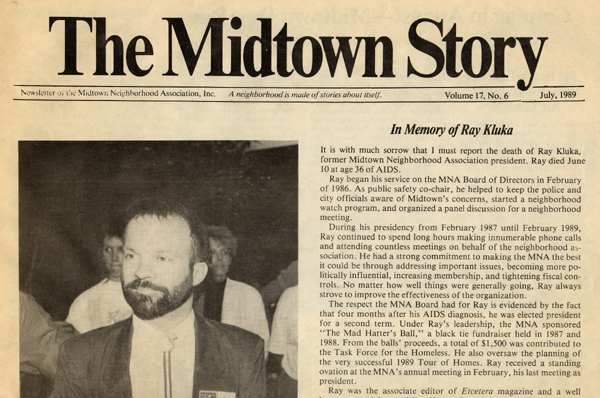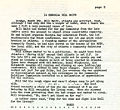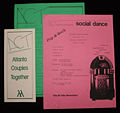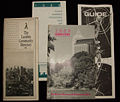Difference between revisions of "AIDS and Politics - 1980 to 1989"
| Line 32: | Line 32: | ||
Image:Atlanta Couples Together_1986_AARL.jpg|Printed materials related to Atlanta Couples Together, 1986. During the 1980s, various social and civic LGBT organizations formed to meet specific community needs, including Atlanta Couples Together. Courtesy of the Archives Division, Auburn Avenue Research Library on African American Culture and History. | Image:Atlanta Couples Together_1986_AARL.jpg|Printed materials related to Atlanta Couples Together, 1986. During the 1980s, various social and civic LGBT organizations formed to meet specific community needs, including Atlanta Couples Together. Courtesy of the Archives Division, Auburn Avenue Research Library on African American Culture and History. | ||
| − | Image:TowerLounge_AHC.jpg|Photograph, Tower Lounge staff, circa 1988. Now closed, one of the longest-surviving lesbians bars in the city was the Tower Lounge. In the 1980s, other bars for gay women included Arney's, Sportspage, and Toolulah's. Photographer unknown. Courtesy of the Kenan Research Center at the Atlanta History Center. | + | Image:TowerLounge_AHC.jpg|Photograph, Tower Lounge staff, circa 1988. Now closed, one of the longest-surviving lesbians bars in the city was the Tower Lounge. In the 1980s, other bars for gay women included Arney's, Deana's One Mo' Time, Rose, Sportspage, and Toolulah's. Photographer unknown. Courtesy of the Kenan Research Center at the Atlanta History Center. |
| − | Image:139.jpg|Photograph, Armorettes, circa 1983. For thirty years, the Armorettes, "Camp Drag Queens of the South," | + | Image:139.jpg|Photograph, Armorettes, circa 1983. For thirty years, the Armorettes, "Camp Drag Queens of the South," entertained locals and visitors alike while establishing a rich tradition of community service. When the Armory closed in the early 2000s, the Armorette's moved to Burkhart's. Photographer unknown. Courtesy of the Kenan Research Center at the Atlanta History Center. |
Image:140.jpg|Advertisement featuring performer RuPaul, Weekends, 1984. Until he left for New York in 1987, RuPaul was involved in Atlanta's arts and nightlife scenes, recording and performing songs and starring in the 1986 Jon Witherspoon cult film, ''Starbooty''. Courtesy of the Kenan Research Center at the Atlanta History Center. | Image:140.jpg|Advertisement featuring performer RuPaul, Weekends, 1984. Until he left for New York in 1987, RuPaul was involved in Atlanta's arts and nightlife scenes, recording and performing songs and starring in the 1986 Jon Witherspoon cult film, ''Starbooty''. Courtesy of the Kenan Research Center at the Atlanta History Center. | ||
| Line 40: | Line 40: | ||
Image:Insight newsletter_AHC_1985.jpg|Newsletter, the Montgomery Foundation Gender Dysphoric Association, 1985. "Insight," a local monthly publication of the Montgomery Foundation, sought to educate transexual individuals and professional service providers about the issues affecting trans women and men. Courtesy of the Kenan Research Center at the Atlanta History Center. | Image:Insight newsletter_AHC_1985.jpg|Newsletter, the Montgomery Foundation Gender Dysphoric Association, 1985. "Insight," a local monthly publication of the Montgomery Foundation, sought to educate transexual individuals and professional service providers about the issues affecting trans women and men. Courtesy of the Kenan Research Center at the Atlanta History Center. | ||
| − | Image:Atlanta Gay Guides_1986-1989_AARL.jpg| | + | Image:Atlanta Gay Guides_1986-1989_AARL.jpg|Directories, 1986-1989. The Atlanta Business and Professional Guild, founded in 1978, was one of several organizations that published annual directories. Now the guides provide historic snapshots of the city's LGBT growing infrastructure of organizations, social groups, and businesses during the 1980s. Courtesy of the Archives Division, Auburn Avenue Research Library on African American Culture and History. |
| Line 48: | Line 48: | ||
<gallery> | <gallery> | ||
| − | Image:131.jpg|Cover, ''The News'', 1985. Courtesy of the Kenan Research Center at the Atlanta History Center. | + | Image:131.jpg|Cover, ''The News'', 1985. ''The News'', a publication of the Atlanta Gay Center, reported on the ongoing Hardwick Case and the Center's move to Twelfth Street in Midtown. Courtesy of the Kenan Research Center at the Atlanta History Center. |
| − | Image:Atlanta March 1987_AARL.jpg|Printed materials related to the formation of an Atlanta committee for the National March on Washington, 1987. Courtesy of the Archives Division, Auburn Avenue Research Library on African American Culture and History. | + | Image:Atlanta March 1987_AARL.jpg|Printed materials related to the formation of an Atlanta committee for the National March on Washington, 1987. During the 1980s, LGBT Atlantans continued community development efforts while also fostering a national gay identity, illustated here by preparations for the 1987 National March on Washington. Courtesy of the Archives Division, Auburn Avenue Research Library on African American Culture and History. |
| − | Image:Cover_ETC_1989_AARL.jpg|Courtesy of the Archives Division, Auburn Avenue Research Library on African American Culture and History. | + | Image:Cover_ETC_1989_AARL.jpg|Cover, ''Etcetera'' 1989. In addition to local and national marches for LGBT civil rights, LGBT Atlantans partipated in other human rights demonstrations, including the Martin Luther King Day Parade. Members are the African American Lesbian Gay Alliance in attendance were pictured on the 27 January-2 February cover of ''Etcetera''. Courtesy of the Archives Division, Auburn Avenue Research Library on African American Culture and History. |
Image:Names Project_1988_AARL.jpg|Printed materials related to the [[AIDS Memorial Quilt: November 1985-present|Names Project]] in Atlanta, Georgia, 1988. Courtesy of the Archives Division, Auburn Avenue Research Library on African American Culture and History. | Image:Names Project_1988_AARL.jpg|Printed materials related to the [[AIDS Memorial Quilt: November 1985-present|Names Project]] in Atlanta, Georgia, 1988. Courtesy of the Archives Division, Auburn Avenue Research Library on African American Culture and History. | ||
Revision as of 15:06, 8 June 2010
AIDS and Politics - 1980 to 1989
The popularity of bars and parties did not wane in the 1980s, but the gay and social political landscape of Atlanta, as in other major cities, was transformed by the AIDS crisis. Though AIDS first came to national attention in 1981, in Atlanta, thanks in part to the presence of the Centers for Disease Control, gay activists began organizing around the issue as early as 1983. AID Atlanta, an all-volunteer educational and service organization, was among the first groups that formed. By the end of the decade, there existed a network of HIV/AIDS support and activist groups, including a local chapter of the AIDS Coalition to Unleash Power (ACT-UP) and programs and organizations to address women and communities of color.
Flyer, First Tuesday, 1980. First Tuesday assessed Republican Newt Gringrich, and many other elected officials, to be "unacceptable" for supporting the anti-gay McDonald amendment, named after local Congressman Larry McDonald, to the Legal Services Corporation Act. Courtesy of the Kenan Research Center at the Atlanta History Center.
Letter, National Task Force on AIDS Prevention of the National Association, Black and White Men Together, 1988. Project Director Reggie Williams contacts BWMT chapter members, including Duncan Teague of Atlanta. Courtesy of the Archives Division, Auburn Avenue Research Library on African American Culture and History.
Much, though not all, activism during this decade centered on AIDS, and lesbians played an important role in the movement to educate people and to combat the increasingly vocal antigay forces from the Christian right and the Republican Party. As the crisis escalated, Evangelical ministers, among them Charles Stanley of the First Baptist Church of Atlanta, preached that HIV/AIDS was God's punishment for homosexuality. When Georgia native J. B. Stoner, a lifelong segregationist and white supremacist, led a mob confronting civil rights marchers in Forsyth County, Georgia, in 1987, he passed out leaflets that read "Praise God for AIDS" across the top. In the clip below, local entertainment personalities RuPaul and Wanda Peek document their participation in the march. <youtube>hntVo25hOgo</youtube>
Printed materials related to Evangelical Outreach Ministries (EOM), 1985. By the mid-1980s, various religious organizations existed, including EOM and local synagogue Bet Havarim, to cater to the city's diverse LGBT communities of faith. Courtesy of the Archives Division, Auburn Avenue Research Library on African American Culture and History.
Printed materials related to Atlanta's gay ordinance, 1986. The growing LGBT community responds to efforts to repeal newly-won civil rights protections in Atlanta. Arch conservative Nancy Schaefer's Citizens for Public Awareness attempts to repeal the city's ordinance but fails. Courtesy of the Archives Division, Auburn Avenue Research Library on African American Culture and History.
Printed materials related to Atlanta Couples Together, 1986. During the 1980s, various social and civic LGBT organizations formed to meet specific community needs, including Atlanta Couples Together. Courtesy of the Archives Division, Auburn Avenue Research Library on African American Culture and History.
Photograph, Tower Lounge staff, circa 1988. Now closed, one of the longest-surviving lesbians bars in the city was the Tower Lounge. In the 1980s, other bars for gay women included Arney's, Deana's One Mo' Time, Rose, Sportspage, and Toolulah's. Photographer unknown. Courtesy of the Kenan Research Center at the Atlanta History Center.
Photograph, Armorettes, circa 1983. For thirty years, the Armorettes, "Camp Drag Queens of the South," entertained locals and visitors alike while establishing a rich tradition of community service. When the Armory closed in the early 2000s, the Armorette's moved to Burkhart's. Photographer unknown. Courtesy of the Kenan Research Center at the Atlanta History Center.
Advertisement featuring performer RuPaul, Weekends, 1984. Until he left for New York in 1987, RuPaul was involved in Atlanta's arts and nightlife scenes, recording and performing songs and starring in the 1986 Jon Witherspoon cult film, Starbooty. Courtesy of the Kenan Research Center at the Atlanta History Center.
Newsletter, the Montgomery Foundation Gender Dysphoric Association, 1985. "Insight," a local monthly publication of the Montgomery Foundation, sought to educate transexual individuals and professional service providers about the issues affecting trans women and men. Courtesy of the Kenan Research Center at the Atlanta History Center.
Directories, 1986-1989. The Atlanta Business and Professional Guild, founded in 1978, was one of several organizations that published annual directories. Now the guides provide historic snapshots of the city's LGBT growing infrastructure of organizations, social groups, and businesses during the 1980s. Courtesy of the Archives Division, Auburn Avenue Research Library on African American Culture and History.
During the same period, another event of national import occurred, when in 1982, Atlantan Michael Hardwick was arrested in his bedroom for engaging in oral sex with another man. Hardwick appealed, aided by the ACLU and Georgians Opposed to Archaic Laws, but in 1986 the case reached the U.S. Supreme Court, which upheld Georgia’s sodomy statute. In response to the Hardwick case, a strong belief that the U.S. government was failing to adequately address the AIDS crisis, and ongoing discrimination, LGBT Atlantans responded vocally and visibly in local marches and rallies, as well as the second national March on Washington for Lesbian and Gay Rights in 1987.
Printed materials related to the formation of an Atlanta committee for the National March on Washington, 1987. During the 1980s, LGBT Atlantans continued community development efforts while also fostering a national gay identity, illustated here by preparations for the 1987 National March on Washington. Courtesy of the Archives Division, Auburn Avenue Research Library on African American Culture and History.
Cover, Etcetera 1989. In addition to local and national marches for LGBT civil rights, LGBT Atlantans partipated in other human rights demonstrations, including the Martin Luther King Day Parade. Members are the African American Lesbian Gay Alliance in attendance were pictured on the 27 January-2 February cover of Etcetera. Courtesy of the Archives Division, Auburn Avenue Research Library on African American Culture and History.
Printed materials related to the Names Project in Atlanta, Georgia, 1988. Courtesy of the Archives Division, Auburn Avenue Research Library on African American Culture and History.

Parties and Pride - 1970 to 1979
Collective Power and Culture Wars - 1990 to 1999
Atlanta Since Stonewall, 1969-2009: A Local History <comments />























